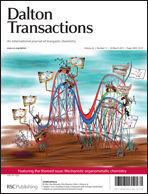Computational study of the double C–Cl bond activation of dichloromethane and phosphinealkylation at [CoCl(PR3)3]†
Abstract
Density functional theory calculations have been employed to model the double C–Cl bond
![Graphical abstract: Computational study of the double C–Cl bond activation of dichloromethane and phosphine alkylation at [CoCl(PR3)3]](/en/Image/Get?imageInfo.ImageType=GA&imageInfo.ImageIdentifier.ManuscriptID=C2DT32272B&imageInfo.ImageIdentifier.Year=2013)
- This article is part of the themed collection: Mechanistic Organometallic Chemistry

 Please wait while we load your content...
Please wait while we load your content...